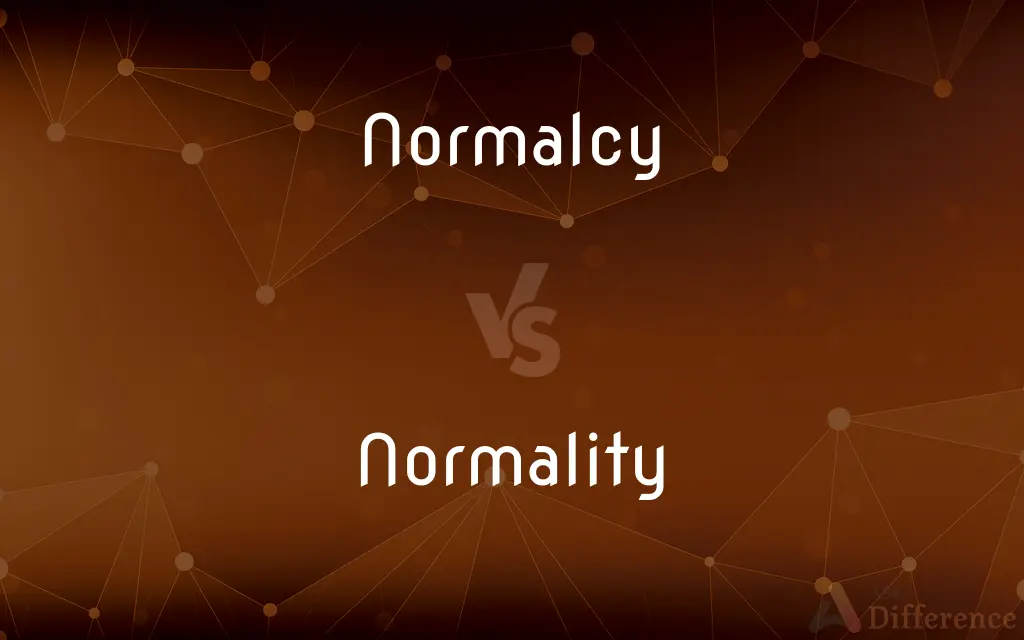Normalcy vs. Normality — What's the Difference?
By Fiza Rafique & Maham Liaqat — Updated on June 2, 2024
Normalcy refers to the condition of being normal, often emphasizing a return to a typical state after a period of disturbance, while normality focuses on the state or quality of being normal in a broader, more general sense.

Difference Between Normalcy and Normality
Table of Contents
ADVERTISEMENT
Key Differences
Normalcy is commonly used to describe the return to a familiar or expected state, especially after a time of upheaval or abnormal circumstances. It implies a restoration of routine or standard conditions. On the other hand, normality encompasses the broader concept of conforming to a standard, usual, or expected state, without the specific connotation of a return from disruption.
While normalcy has been popularized in certain contexts, particularly in political or social discourse to signify the return to stable conditions, normality is more widely used in scientific, mathematical, and technical fields to describe conditions that conform to a norm or standard.
The term "normalcy" gained prominence in the United States following President Warren G. Harding's use of the word in his 1920 campaign, advocating for a return to pre-World War I conditions. Normality, however, has a longer history in the English language and is preferred in many English-speaking regions outside the United States.
In everyday language, normalcy and normality can often be used interchangeably without significant loss of meaning, especially when referring to the general state of being normal. However, in specific contexts, the choice between the two might be influenced by regional preferences, historical usage, or the desire to convey a particular nuance.
Despite their slight differences in connotation and usage, both terms ultimately relate to the concept of normality, serving to describe situations, conditions, or behaviors that adhere to what is standard, typical, or expected within a given context.
ADVERTISEMENT
Comparison Chart
Definition
The condition of being normal, especially after a period of disruption
The state or quality of being normal; conformity to a standard or norm
Usage Context
Often used in political, social, and everyday discourse
More common in scientific, mathematical, and technical language
Connotation
Emphasizes a return to normal conditions
Focuses on the general state of being normal
Historical Usage
Popularized in the US by President Warren G. Harding in the 1920s
Has a longer history and is widely used internationally
Interchangeability
Can be used interchangeably with normality in many contexts, but may carry specific nuances
Generally preferred in formal and technical contexts outside the US
Compare with Definitions
Normalcy
Everyday usage in the US.
Americans often speak of normalcy when discussing life after significant events.
Normality
Conforming to a standard.
The scientist measured the parameters to ensure they were within normality.
Normalcy
Restoration of routine.
After months of upheaval, the town longed for a sense of normalcy.
Normality
State of being normal.
The normality of daily life was comforting to her.
Normalcy
Return to usual conditions.
The community celebrated the return to normalcy after the natural disaster.
Normality
Broader application.
Discussions on mental health often involve the concept of normality.
Normalcy
Political and social context.
The campaign promised a path back to normalcy and stability.
Normality
Used in formal contexts.
The legal document outlined the conditions for restoring normality to the operations.
Normalcy
Conveys a specific nuance.
The term 'normalcy' often implies a relief from previous disturbances.
Normality
Preferred internationally.
In many English-speaking countries, 'normality' is the more commonly used term.
Normalcy
Normality.
Normality
The state or fact of being normal; normalcy.
Normalcy
(US) The state of being normal; the fact of being normal; normality.
Normality
Abbr. N(Chemistry) The concentration of a solution expressed as the number of gram equivalent weights of solute per liter of solution.
Normalcy
The quality, state, or fact of being normal; the normal situation or condition; as, the point of normalcy.
Normality
(uncountable) The state of being normal or usual; normalcy.
Jessie was going to wear pants to school, but her brother persuaded her to wear shorts to preserve normality.
Normalcy
Being within certain limits that define the range of normal functioning
Normality
(chemistry) The concentration of a solution expressed in gram equivalent weights of solute per litre of solution.
Normalcy
Expectedness as a consequence of being usual or regular or common
Normality
A measure of how well an observed distribution approximates a normal distribution.
Normality
Conformity with the norm; the state of being normal; the normal condition.
Normality
(of a solution) concentration expressed in gram equivalents of solute per liter
Normality
Being within certain limits that define the range of normal functioning
Normality
Expectedness as a consequence of being usual or regular or common
Normality
Conformity with the norm
Common Curiosities
What is normalcy?
Normalcy refers to the condition or state of being normal, often with an emphasis on returning to normal after a period of disruption.
Can normalcy and normality be used interchangeably?
In many everyday contexts, they can be used interchangeably without significant change in meaning, though some might prefer one over the other based on regional usage or specific nuances.
What does normality mean?
Normality denotes the state or quality of being normal, aligning with what is standard, usual, or expected in a given context.
Which term is preferred in scientific contexts?
Normality is generally preferred in scientific, mathematical, and technical contexts due to its broader application and historical usage.
How do normalcy and normality differ?
The main difference lies in their connotations: normalcy often implies a return to normal conditions, while normality has a broader meaning related to general conformity to norms.
Is normalcy a real word?
Yes, normalcy is a real word and became widely used in the United States, particularly after President Warren G. Harding's use of it in the 1920s.
Why might someone choose to use normalcy over normality?
Someone might choose to use normalcy to specifically emphasize a return to normal conditions after a period of disruption, or due to regional preferences in language.
What impact did President Warren G. Harding have on the use of normalcy?
Harding's use of "normalcy" in his presidential campaign popularized the term in the United States, associating it with a desire to return to pre-war conditions.
Is normality more commonly used outside the United States?
Yes, normality tends to be more commonly used and accepted in English-speaking countries outside the United States.
How do media and literature influence the use of these terms?
Media and literature can play a significant role in popularizing certain terms and their connotations, influencing public preference and understanding of normalcy and normality.
How do cultural perceptions influence the choice between normalcy and normality?
Cultural perceptions and historical context can influence the preference for one term over the other, with some cultures or regions showing a clear preference based on usage history and connotations.
Are there contexts where one term is significantly more appropriate than the other?
In contexts where there's a specific emphasis on the aspect of returning to normal after disruption, "normalcy" might be more appropriate; in technical or scientific discussions, "normality" is generally preferred.
Can the preference for normalcy or normality vary by industry or profession?
Yes, industry or professional context can influence the preference, with normality being more prevalent in formal, scientific, and technical fields.
How do normalcy and normality relate to societal standards?
Both terms relate to societal standards by describing conditions or behaviors that align with what is considered standard, typical, or expected within a society.
Is the choice between normalcy and normality subjective?
The choice can be subjective, often influenced by personal preference, regional usage, and the specific context or nuance intended by the speaker or writer.
Share Your Discovery

Previous Comparison
Abound vs. Abase
Next Comparison
Unorganized vs. DisorganizedAuthor Spotlight
Written by
Fiza RafiqueFiza Rafique is a skilled content writer at AskDifference.com, where she meticulously refines and enhances written pieces. Drawing from her vast editorial expertise, Fiza ensures clarity, accuracy, and precision in every article. Passionate about language, she continually seeks to elevate the quality of content for readers worldwide.
Co-written by
Maham Liaqat















































